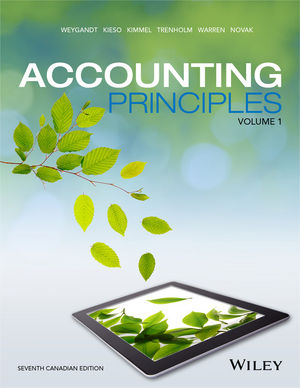Accounting Principles 7Th Canadian Edition Volume 1 By Jerry J. Weygandt
In Stock
Original price was: $55.00.$25.00Current price is: $25.00.
Accounting Principles 7Th Canadian Edition Volume 1 By Jerry J. Weygandt
TABLE OF CONTENTS
Test Bank for Accounting Principles, 7th Canadian Edition Volume 1 by Jerry J. Weygandt
The “Test Bank for Accounting Principles, 7th Canadian Edition Volume 1” by Jerry J. Weygandt, Donald E. Kieso, and Paul D. Kimmel is an invaluable educational resource designed to support both educators and students in mastering the fundamental principles and practices of accounting. This comprehensive test bank complements the textbook by offering a variety of questions that assess and reinforce understanding of key accounting concepts and practical skills, making it an essential tool for both teaching and learning. Below is a detailed overview of the components and benefits of this test bank:
Overview of Test Bank Content
- Chapter-by-Chapter Organization
- The test bank is meticulously organized to align with each chapter of the textbook. This ensures comprehensive coverage of all critical topics and provides a structured approach to assessment, facilitating easy integration into the curriculum and enabling targeted learning.
- Types of Questions
- Multiple-Choice Questions (MCQs): These questions cover a broad spectrum of knowledge, from basic recall to complex application and critical thinking. Each question includes well-crafted distractors to challenge students’ understanding.
- True/False Questions: These questions assess students’ ability to distinguish between correct and incorrect statements, reinforcing factual knowledge and addressing common misconceptions.
- Fill-in-the-Blank Questions: These questions focus on recalling specific details such as key terms, processes, and important concepts, testing students’ memory and understanding.
- Short Answer Questions: These questions require detailed yet concise responses, evaluating students’ ability to explain accounting concepts clearly and accurately.
- Essay Questions: These questions assess students’ ability to synthesize and articulate complex ideas, demonstrating a deep understanding of accounting principles and their applications.
- Problem-Solving Questions: These questions involve practical accounting problems that require students to apply theoretical knowledge to real-world scenarios, enhancing their analytical and problem-solving skills.
- Diagram-Based Questions: These questions involve interpreting, analyzing, or creating diagrams related to accounting concepts, reinforcing visual and analytical skills.
- Difficulty Levels
- Questions are categorized by difficulty to provide a range of challenges and assess students’ proficiency at different levels, including:
- Basic: Testing foundational knowledge and comprehension.
- Intermediate: Requiring application of knowledge to practical accounting scenarios.
- Advanced: Involving critical thinking, analysis, and synthesis of complex accounting information.
- Questions are categorized by difficulty to provide a range of challenges and assess students’ proficiency at different levels, including:
- Core Focus Areas
- Introduction to Accounting and Business: Questions covering the basic principles and scope of accounting, including the purpose and importance of accounting in business decision-making.
- The Accounting Cycle: Detailed coverage of the steps in the accounting cycle, including journalizing transactions, posting to the ledger, preparing trial balances, and adjusting entries.
- Accrual Accounting Concepts: Assessing knowledge of accrual accounting principles, including revenue recognition, expense recognition, and the matching principle.
- Merchandising Operations: Questions on accounting for merchandising operations, including sales transactions, cost of goods sold, and inventory management.
- Inventory Costing: Focus on inventory valuation methods, including FIFO, LIFO, and weighted-average cost, and their impact on financial statements.
- Internal Control and Cash: Examining internal control procedures, cash management, and bank reconciliation processes.
- Receivables: Coverage of accounting for receivables, including accounts receivable, notes receivable, and the allowance method for uncollectible accounts.
- Plant Assets, Natural Resources, and Intangible Assets: Questions on the acquisition, depreciation, amortization, and disposal of long-lived assets.
- Liabilities: Detailed explanations for accounting for current and long-term liabilities, including notes payable, bonds payable, and payroll liabilities.
- Equity: Assessing understanding of shareholders’ equity, including common stock, preferred stock, dividends, and retained earnings.
- Financial Statement Analysis: Questions on techniques for analyzing financial statements, including ratio analysis, horizontal analysis, and vertical analysis.
- Alignment with Learning Objectives
- Each question in the test bank is aligned with the learning objectives outlined in the textbook, ensuring that assessments are relevant and targeted toward achieving the intended educational outcomes. This alignment helps in accurately measuring students’ progress and comprehension.
- Educational Support and Utility
- For Educators: The test bank provides a comprehensive resource for creating quizzes, exams, and other assessments. It simplifies the process of test creation and ensures consistency and alignment with the curriculum.
- For Students: The test bank serves as a valuable tool for self-assessment and study. It helps students verify their answers, understand their mistakes, and learn the correct approach to solving accounting problems.
Benefits of Using the Test Bank
- Enhanced Learning and Retention
- The diverse range of question types and difficulty levels helps reinforce learning through varied and repeated exposure to key concepts, enhancing retention and understanding.
- Preparation for Real-World Applications
- By focusing on real-world scenarios and practical applications, the test bank prepares students for the practical aspects of accounting, ensuring they are ready to apply their knowledge in professional settings.
- Comprehensive Assessment
- The test bank allows for thorough and multi-faceted evaluation of students’ knowledge and skills, from basic understanding to advanced application, ensuring a well-rounded educational experience.
- Efficient Teaching Resource
- For educators, the test bank simplifies the process of creating assessments, providing a consistent and reliable tool for evaluating students’ progress and readiness for advanced studies in accounting.
Conclusion
The “Test Bank for Accounting Principles, 7th Canadian Edition Volume 1” by Jerry J. Weygandt, Donald E. Kieso, and Paul D. Kimmel is an essential resource for accounting education. It provides structured, comprehensive, and versatile tools for assessing and enhancing students’ knowledge and skills in accounting. By aligning closely with the textbook and emphasizing real-world application, the test bank supports the development of competent, confident professionals ready to excel in their understanding and application of accounting principles in various business and financial settings.


Reviews
There are no reviews yet.